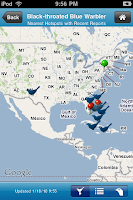Many bird species are known to cooperate to mob and scold predators such as hawks, owls, or outdoor cats. In North America this behavior is probably most noticeable among jays and crows since they form the loudest mobs. Chickadees and titmice likewise gather to scold a predator when one is found. Other species may participate or use their own cooperative actions to confuse and drive away predators. The general strategy is to gather around a predator and scold while moving around just out of striking distance until the predator becomes frustrated and departs.
It is clear that cooperation benefits prey species. Most predators of birds rely to some degree on surprise, and if one or more birds is drawing attention to a predator's presence, that advantage is gone. Predators also need to be also to focus their attacks precisely, something difficult to do while a lot of noisy birds are flying around nearby. However, it is not obvious why birds would evolve such behaviors. If you consider evolution in terms of competition for resources and survival, it may be in the self-interest of some birds to see other birds culled from the population. Mobbing also exposes individual birds to some risk; if one strays too close to a targeted predator, it could easily be injured or killed.
So what drives some species to cooperate to fend off predators instead of hunkering down and hiding? One group of researchers decided to test
whether the risk of predation influenced birds' willingness to mob predators. To do so they studied the reactions of Pied Flycatchers (
Ficedula hypoleuca) to dummy predators near their nests during breeding season.
The researchers provided paired nestboxes to attract breeding flycatchers to their study site. Only pairs in which both nestboxes were occupied were used in the study. Once the birds were settled into the nestboxes, researchers trained the birds for five days. Some pairs of nests were presented with a stuffed Tawny Owl (
Strix aluco) and playback of Pied Flycatcher alarm calls to condition them to expect a high risk of predation. Other nests received a visit from a stuffed Mistle Thrush (
Turdus viscivorus) so that they would expect lower risk.
In the experiments, the researchers placed the stuffed Tawny Owl on a platform near each of the nestbox pairs with the owl facing one of the nests. This time there was no audio playback so that the flycatchers would have to find it themselves, and the owl was presented to both the high-risk and low-risk groups. Researchers then watched from a blind to see if birds from the neighboring nest would assist the ones whose nest was threatened. Markings on the trees around the nestboxes allowed the minimum approach distance to be measured from the blind. After 10 minutes of mobbing the stuffed owl was removed, and then an hour later the experiment was repeated with the other nestbox in the pair.
Minimum approach distance from the stuffed owl by nest owners and neighbouring flycatchers. Source: Proc. R. Soc. B 22 February 2010 vol. 277 no. 1681 513-518 doi: 10.1098/rspb.2009.1614
As one might expect, the owners of the nest directly under threat had the most intense reaction to the stuffed predator. In fact, the nestbox owners in the high-risk and low-risk groups differed little in their responses. However, we do see a difference in the reactions of flycatchers from the neighboring nestboxes. Among the high-risk group, neighbors always came to the assistance of the nestbox pairs, versus 61.5% of the time in the low-risk group. Neighboring birds from the high-risk group also mobbed more intensely than neighbors from the low-risk group, although in both cases the neighbors reacted less intensely than the nestbox owners. When the tests were repeated an hour later, the results were similar.
For Pied Flycatchers, at least, the increased risk of predation encourages neighboring nesting pairs to cooperate to remove one threat to their success. This may happen through learned reciprocity. Alarm by one nest owner might attract the attention of other nesters, and their reactions might encourage the first nest owner to come to their assistance in turn. The authors further suggest that other types of cooperative behavior might have a similar origin in risky environments.
 Krams, I., Berzins, A., Krama, T., Wheatcroft, D., Igaune, K., & Rantala, M. (2009). The increased risk of predation enhances cooperation Proceedings of the Royal Society B: Biological Sciences, 277 (1681), 513-518 DOI: 10.1098/rspb.2009.1614
Krams, I., Berzins, A., Krama, T., Wheatcroft, D., Igaune, K., & Rantala, M. (2009). The increased risk of predation enhances cooperation Proceedings of the Royal Society B: Biological Sciences, 277 (1681), 513-518 DOI: 10.1098/rspb.2009.1614






































